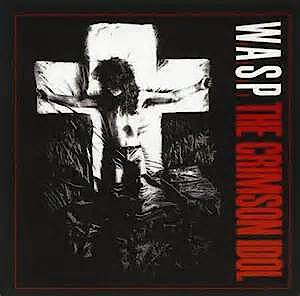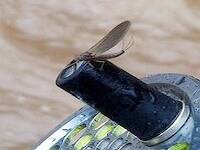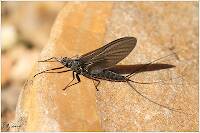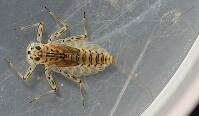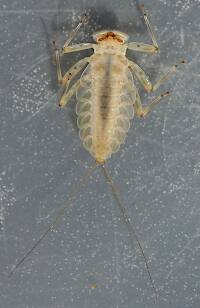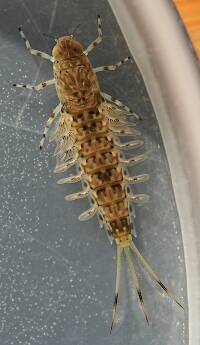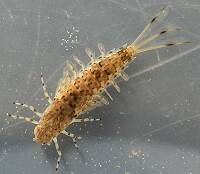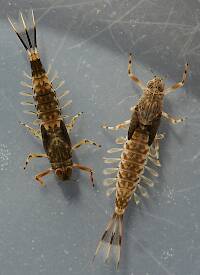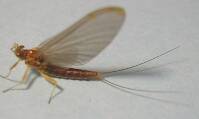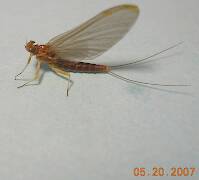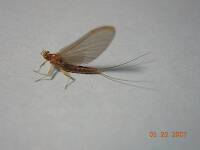
Salmonflies
Pteronarcys californica
The giant Salmonflies of the Western mountains are legendary for their proclivity to elicit consistent dry-fly action and ferocious strikes.
Featured on the forum

Troutnut is a project started in 2003 by salmonid ecologist Jason "Troutnut" Neuswanger to help anglers and
fly tyers unabashedly embrace the entomological side of the sport. Learn more about Troutnut or
support the project for an enhanced experience here.
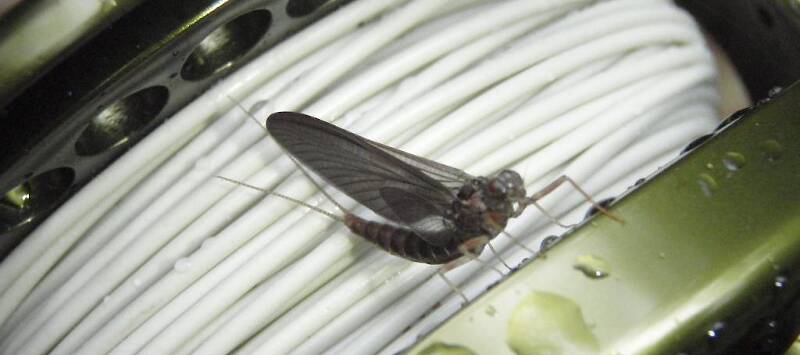
Adirman on May 13, 2013May 13th, 2013, 1:31 pm EDT
Guys;
A guy on another forum I frequent posted some pics from this past weekends outing up to the catskills. in one of the pics, he identified a a mayfly that landed on his flyrod as a quill gordon dun. To me, it looks more like a blue quill. Both species look pretty similar and are hard to tell apart to my untrained eye. Any advice on iding these 2 that is more obvious, perhaps say, a big diff. in size or something?
Thanks alot,
P.S. heres a pic of the bug!
Adirman
A guy on another forum I frequent posted some pics from this past weekends outing up to the catskills. in one of the pics, he identified a a mayfly that landed on his flyrod as a quill gordon dun. To me, it looks more like a blue quill. Both species look pretty similar and are hard to tell apart to my untrained eye. Any advice on iding these 2 that is more obvious, perhaps say, a big diff. in size or something?
Thanks alot,
P.S. heres a pic of the bug!
Adirman
PaulRoberts on May 13, 2013May 13th, 2013, 6:17 pm EDT
Siphlonurus?
Entoman on May 13, 2013May 13th, 2013, 10:04 pm EDT
I agree with Paul. It's probably S. quebecensis (Gray Drake). They are the by far the most common eastern species and hatch earlier. Ask your friend if it had V's on each belly segment, Adir. If so, you have your ID.
"It's not that I find fishing so important, it's just that I find all other endeavors of Man equally unimportant... And not nearly as much fun!" Robert Traver, Anatomy of a Fisherman
PaulRoberts on May 14, 2013May 14th, 2013, 11:08 am EDT
Seems late for E. pleuralis, and much different habitat too. E. pleuralis can be similarly colored to freshly emerged Siphlonurus, as well as two-tailed. At first glance I could see how they might be confused. The dun in the image is quite dark and probably had darkened.
Adirman on May 14, 2013May 14th, 2013, 12:45 pm EDT
Thanks guys, for the help but im sure he didn't look under the belly based on what he said in his post. But based on what your saying Entoman, the v's on the underbelly segments is a good way to differentiate the 2?
Also, Brookyman, whats that with the face shape thing?
Most appreciative,
Adirman
Also, Brookyman, whats that with the face shape thing?
Most appreciative,
Adirman
Entoman on May 14, 2013May 14th, 2013, 7:51 pm EDT
...the v's on the underbelly segments is a good way to differentiate the 2?
No, a good way to differentiate from other Siphlonurus species. There are other possibilities besides quebecensis. Epeorus species look quite different with their long legs and different body conformation. Besides very obvious hind wing and tail count differences, Paraleptophlebia species look quite different as well.
"It's not that I find fishing so important, it's just that I find all other endeavors of Man equally unimportant... And not nearly as much fun!" Robert Traver, Anatomy of a Fisherman
PaulRoberts on May 15, 2013May 15th, 2013, 4:07 am EDT
Siphlo is a "swimmer", long in abdomen, rounder in head. Epeorus is a "clinger", shorter in ab, flatter more sprawled across legs, wider in head.
The basic Swimmer, Crawler, Clinger are good general body plan descriptions.
The basic Swimmer, Crawler, Clinger are good general body plan descriptions.
Adirman on May 15, 2013May 15th, 2013, 1:19 pm EDT
Yes, I see your point Brookyman.
Thanks all,
Adirman
Thanks all,
Adirman
Adirman on May 15, 2013May 15th, 2013, 2:04 pm EDT
Entoman;
Went to the insect encyclopedia section and looked up siphlonurus dun pics. They got a real nice pic, I think on page 2, of the v-shaped color pattern you were referring to for the gray drakes.
Thanks for the insight,
Adirman
Went to the insect encyclopedia section and looked up siphlonurus dun pics. They got a real nice pic, I think on page 2, of the v-shaped color pattern you were referring to for the gray drakes.
Thanks for the insight,
Adirman
Entoman on May 15, 2013May 15th, 2013, 3:12 pm EDT
You're welcome, Adirman. Again, not all species of Gray Drakes (Siphlonurus) have those. I brought that character up as a way for you to determine the species, not as a way to separate it from the genera you mentioned. Both of those were already eliminated by other character differences. Sorry for not being clearer about this in my previous posts.
"It's not that I find fishing so important, it's just that I find all other endeavors of Man equally unimportant... And not nearly as much fun!" Robert Traver, Anatomy of a Fisherman
Adirman on May 16, 2013May 16th, 2013, 1:36 pm EDT
No problem, this has been a great thread as Ive learned a lot from you guys!!
Quick Reply
Related Discussions
Topic
Replies
Last Reply
15
Mar 30, 2017
by Crepuscular
by Crepuscular
6
Jun 4, 2016
by Creno
by Creno
4
Dec 22, 2009
by Oldredbarn
by Oldredbarn
Re: Some prospective brookie waters and a delightful surprise! 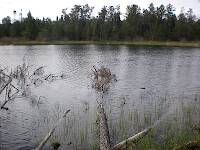
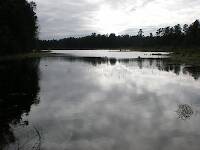
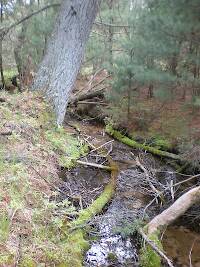
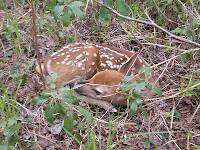
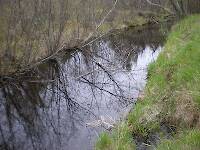
In the Photography Board by Jmd123
+ 6





In the Photography Board by Jmd123
4
May 30, 2011
by PaulRoberts
by PaulRoberts



